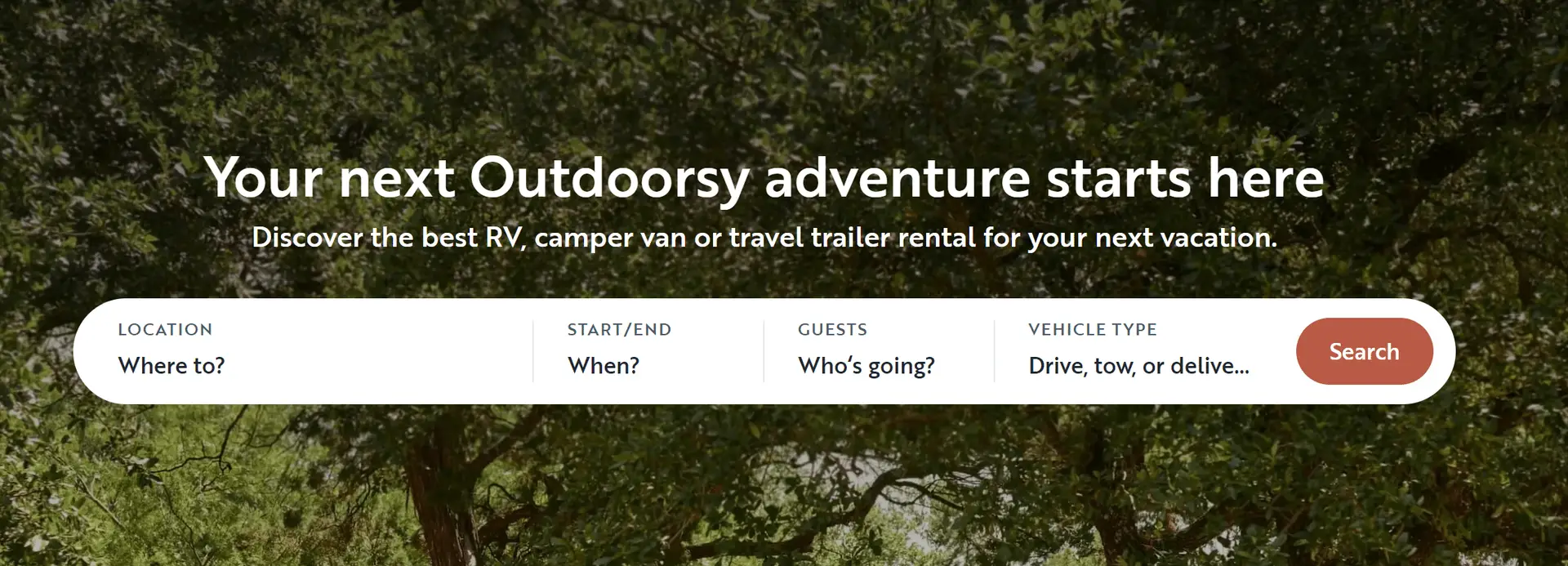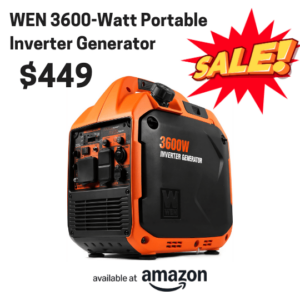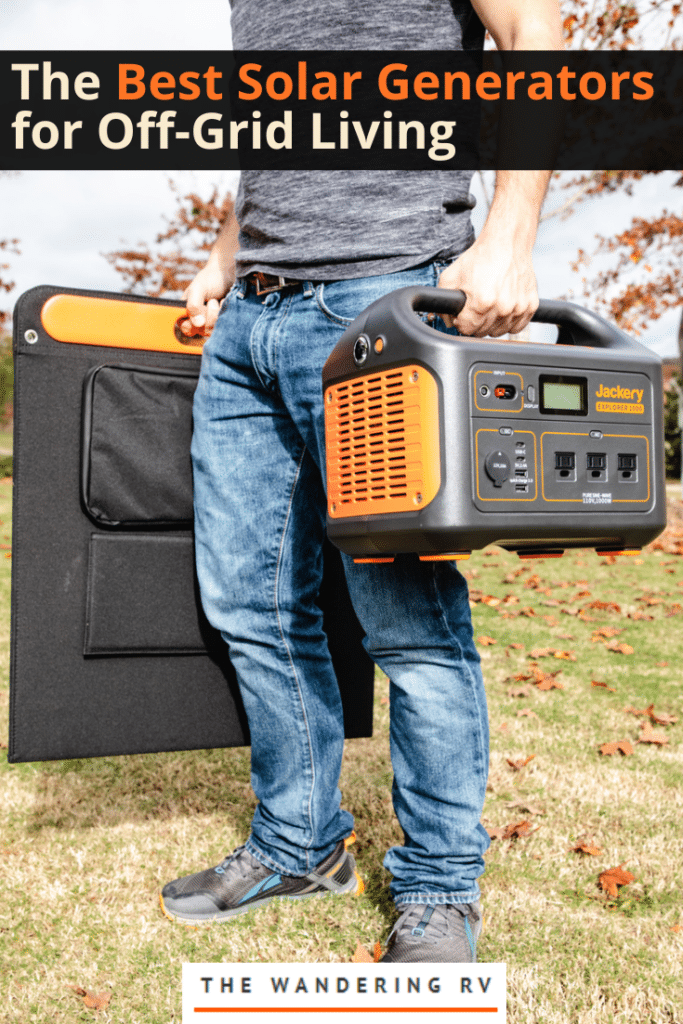
Off-grid living is one of my favorite ways to unplug from the world.
However, even off-grid, we still need access to electricity for basic things like lights, cooking appliances, and keeping our fridge running cold. That’s where off-grid solar generators come in!
I’ve personally used several solar generators on my trips while camping and living off-grid in an RV, and I’ve compared them all to find the best solar generators for off-grid living.
Let’s dive in!
Table of Contents
- What is a Solar Generator?
- Why Use an Off-Grid Solar Generator?
- What Size Generator Do You Need for Off-Grid Living?
- What to Look For in a Solar Generator
- The 3 Best Solar Generators for Off-Grid Living
- Off-Grid Solar Generator FAQs
- Other Off-Grid Essentials
What is a Solar Generator?
A solar generator is a device that converts solar power into electricity.
Essentially, a solar generator is a big battery pack with an AC/DC inverter that can provide 110 volt and 12 volt power.
But it isn’t technically a generator. It’s actually a power station. What generates the electricity are the solar panels you plug into your solar power station.
Here’s how it works, courtesy of Jackery:

But, for the sake of simplicity, I’ll refer to them as solar generators throughout this article, since that’s often what they’re called.
Why Use an Off-Grid Solar Generator?
A portable solar generator is an excellent way of staying off-grid for longer periods of time.
Since they don’t require fuel like traditional gas generators, you don’t have to come back to civilization to get more fuel. As long as there is sunshine, you will have power.
And, unlike most off-grid gas generators, solar generators are extremely quiet. In fact, unless you’re running a heavy load, you probably won’t even hear it.
The only time they make noise is if they’re putting out a lot of power and the cooling fans kick on. And even then, it’s nowhere near the noise of gas or diesel generators.
Finally, solar is a renewable energy, so you can feel good about your power usage. Yay!
What Size Generator Do You Need for Off-Grid Living?
The optimal solar generator size for off-grid living totally depends on your needs.
Most portable solar generators range from 160Wh to 2,000Wh. Of course, some come even smaller or bigger, but these are the sizes you’ll typically see.
The best solar generator for off-grid living depends on how much power you plan on using. For example, if you’re only powering small devices like lights or charging your phone, a tiny 160Wh to 500Wh generator would be more than enough for you to do everything you need indefinitely.
But if you have a fridge, maybe some cooking devices like a toaster or blender, and need to charge bigger devices like laptops, you’re going to want something bigger.
Personally, I’ve found that a 1,000Wh solar generator is the bare minimum to stay off-grid without running out of power. But I prefer even bigger, like 1,500 watts.
I run my fridge, a small water kettle, toaster, lights, and charge multiple devices. So use that as a point of reference.
Check out this article to learn more about what ohms, watts, and volts are if you’re unsure.
Fun Fact: It would take about 7.85 million solar panels to power the entire United States!
What to Look For in a Solar Generator
When it comes to looking for an off-grid solar generator, here’s what’s important:
Battery Capacity
Battery capacity describes how much energy your batteries will store, usually measured in watt-hours (Wh). This is the size I referred to earlier.
Obviously, the bigger the battery, the more electricity it can store and the longer it can power your devices before needing to be recharged.
Battery Type
There are two main types of batteries: lead-acid and lithium-ion batteries.
Lithium-ion batteries are superior to lead-acid in nearly every way – they can store more energy for longer periods of time, don’t require as much maintenance, and hold up for longer than lead-acid batteries.
Inverter
Batteries put out low direct current (DC), which needs to be converted into alternating current (AC) in order to charge most devices.
DC current typically powers 12 volt devices, like anything you can plug into a car charger or cigarette lighter outlet. AC is what powers 110, 120, and 130 volt devices, which is the 2- or 3-pronged plug you see on most household devices.
You want to find generators with a verified pure sine inverter with high efficiency, as these create cleaner power with less energy loss in the DC/AC inversion process.
Power Output
Power output is how much wattage the device can put out without triggering the breaker and shutting down. For example, the Jackery 1500 is a portable power station that can put out up to 1800 watts at a time. The Jackery 300, on the other hand, can only put out 500 watts at once.
That said, you typically don’t want to put out more than 30% of the total capability on a long-term basis. So all of the devices you’re powering with a Jackery 1500 shouldn’t use more than 540 watts. The 1800-watt capability is for very short bursts (5 seconds or less), not for long-duration use.
Obviously, the higher the power output, the more devices you can power with your generator. Again, it depends on your personal needs.
Charging Time
Some solar generators charge faster than others. For example, most of the Ecoflow solar generators charge much faster than their competitors – in fact, it’s one of their selling points.
While some may need a faster charging time (so you can quickly charge via solar panels or a wall outlet), this may not be as important to others. Keep in mind that a faster charging time usually means a faster depletion time, so faster doesn’t always mean better.
Price
Lastly, price matters. If one generator is slightly better than another, but at a way higher price, I’d go with the one that’s not quite as good for significant savings. But again, this comes down to personal preference. Regardless, most solar generators do cost a fair bit of money (though you definitely get your money’s worth).
The 3 Best Solar Generators for Off-Grid Living
Now that you know what makes the best solar generator, let’s look at your options. In order from great to still good, here are my picks for the best portable solar generators for off-grid living:
1. Jackery Solar Generator
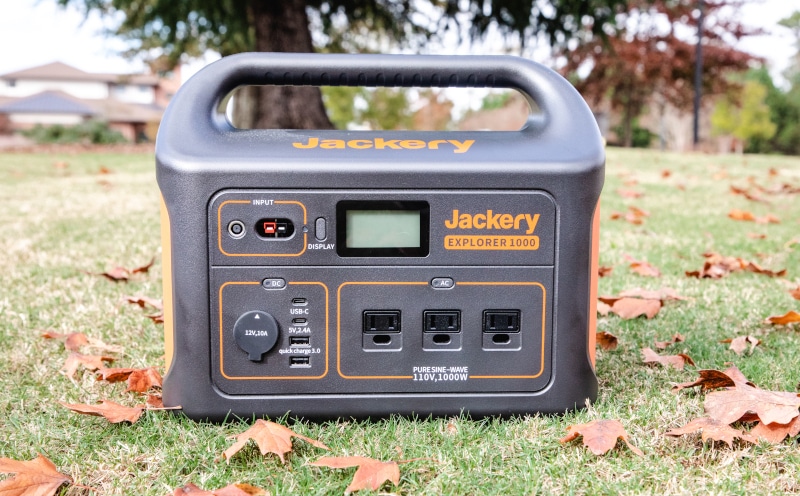
I’ve been using Jackery solar generators for years, and they are my personal favorites (I’d go as far as to say that Jackery produces the best solar generators on the market today).
The design simply works for ease of carrying and moving around; they’re super quiet, and they do exactly what they say they will.
Not to mention, a Jackery solar generator is extremely durable. I accidentally left mine outside in the pouring rain for nearly 30 minutes, and it functioned fine afterward.
I even left it out overnight in freezing temperatures, and it had frost on it in the morning, but it’s still kickin’! I’m not sure if most solar generators could handle that quite like the Jackery solar generator!
Check out our full review of the Jackery 1000 portable power station here.
2. YETI Goal Zero
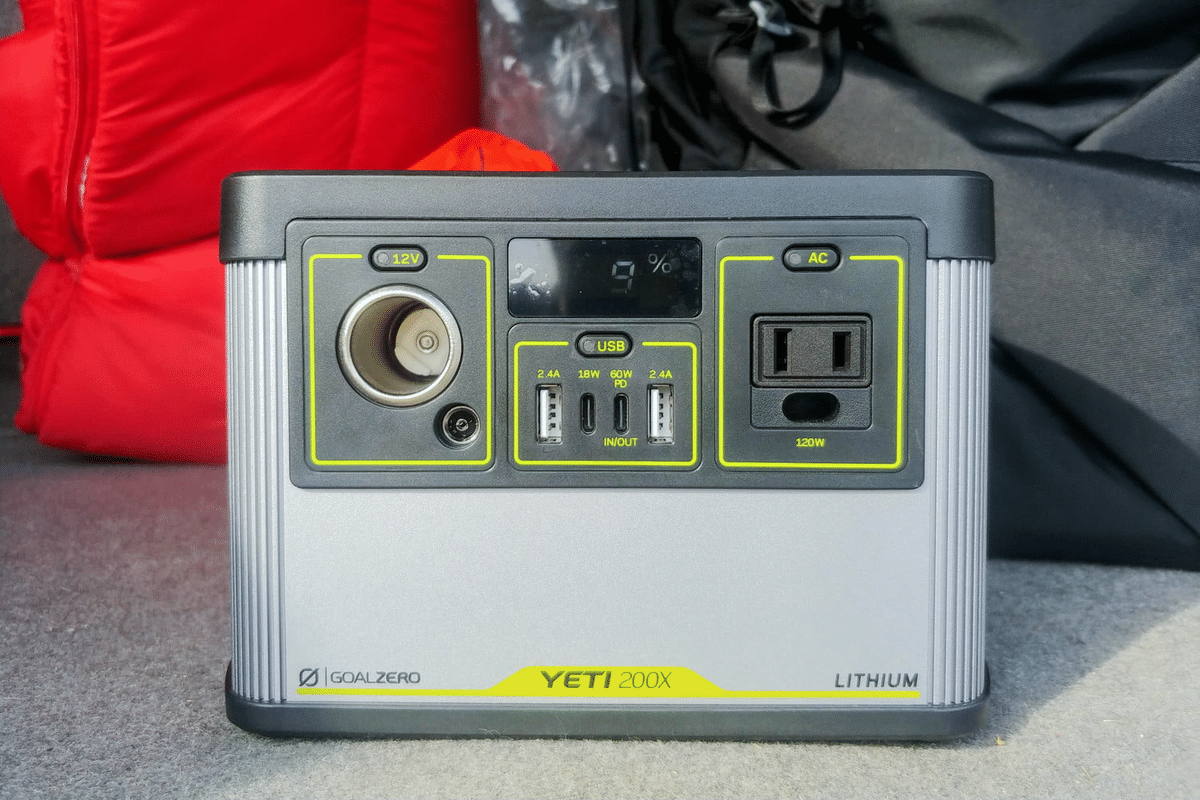
Goal Zero has a suite of portable solar generators that range from 150 watts all the way up to 6000! So you’re sure to find one to fit your needs.
My experience with the YETI solar generator was very similar to the Jackery. They’re both capable, durable, high-quality machines.
The YETI is quite a bit more expensive but does offer a 2-year warranty versus Jackery’s 1-year warranty. So you get a bit more peace of mind with theirs.
Click here to see the Goal Zero generators now.
An in-depth review of the YETI GoalZero solar generators is coming soon!
3. EcoFlow Delta
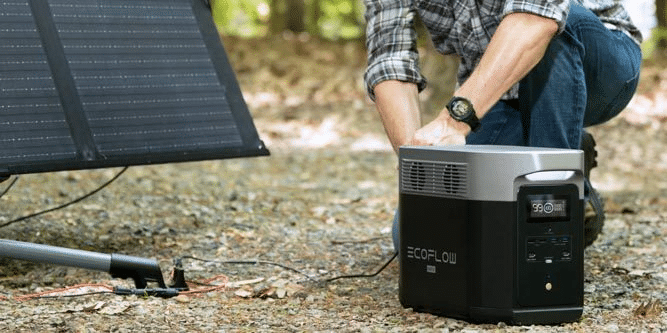
Our runner-up in the lineup is the EcoFlow Delta series. They’re a Chinese manufacturer, and their main selling point is lightning-fast charging times—they can charge off a wall outlet in just one hour, or 4 hours from zero to full in the sunlight.
Price-wise, they’re almost identical to the Jackery lineup. The one downfall of these solar generators is the way they’re laid out—they are heavy and awkward to carry, and their plugs are on opposite sides, so you need to keep all four sides of the solar generator open.
They do have a cool app that lets you monitor and control the device, though, which the competitors don’t have! So this one is best if you’re at a cabin or somewhere with plenty of space to access all sides of the generator and you like the app-control feature.
Click here to see the EcoFlow generators now.
An in-depth review of the EcoFlow Delta Max solar generators is coming soon!
Notable Runner Ups
Here are some others that we’ve tested that are worth looking into!
- BougeRV – Interesting name aside, they have some quality units at the higher end of the price scale.
- Bluetti – I’ve been testing their smallest power station for a few months, and it’s been flawless!
- Zendure – Their power stations are known for VERY fast charging and lots of neat features
Off-Grid Solar Generator FAQs
Here are a few common questions I’m asked about my solar generator:
How much solar power is needed for an off-grid cabin?
The average off-grid cabin usually requires about 7 Kw (or 7000 watts) of power to rely entirely on its own energy production. However, this number varies heavily on your own power needs.
Since most portable solar generators only go up to 3,000 Watts, you’ll most likely need several generators and plenty of solar panels to stay topped off and running at all times.
Check out this guide to learn more about how to calculate the exact amount of power you need.
What size solar generator do you need to run a house?
Usually around 5000 – 7000 Kw is enough to run most device’s in the average home. Obviously, the higher Kw you go, the better.
What will a 1000 watt solar generator run?
A 1000 watt generator can run several small appliances such as lamps, laptops, coffee makers, dishwashers, and even a slow-cooker. They can also run portable refrigerators, small power tools, and even a flat-screen TV if you’re so inclined!
They won’t be able to run most air conditioners, residential refrigerators, or heaters for any significant amount of time.
How big of a solar generator do you need to run a refrigerator?
It depends on the size of the refrigerator. If you’re only running a small portable fridge meant to be used in an RV or while camping, you can get away with a 1000 watt generator. But residential fridges will need 2000 watts or more.
Can you use a solar generator everyday?
Yes, you can use a solar generator every day. However, you should not run it 24/7!
A few tips to maintaining your generator include:
- Only use it for 8-16 hours at a time.
- Never deplete more than 95% of the charge.
- Store it at 30-50% charge rather than full.
Following these tips will help you get the most out of your generator and keep it lasting as long as possible!
Other Off-Grid Essentials
We hope that this guide helped you find the best solar generator for an off-grid living!
If you’re looking to live off-grid or in a van on the road, we have tons of other guides and tips to help you make the most of it.
Check out these other guides and essentials:

